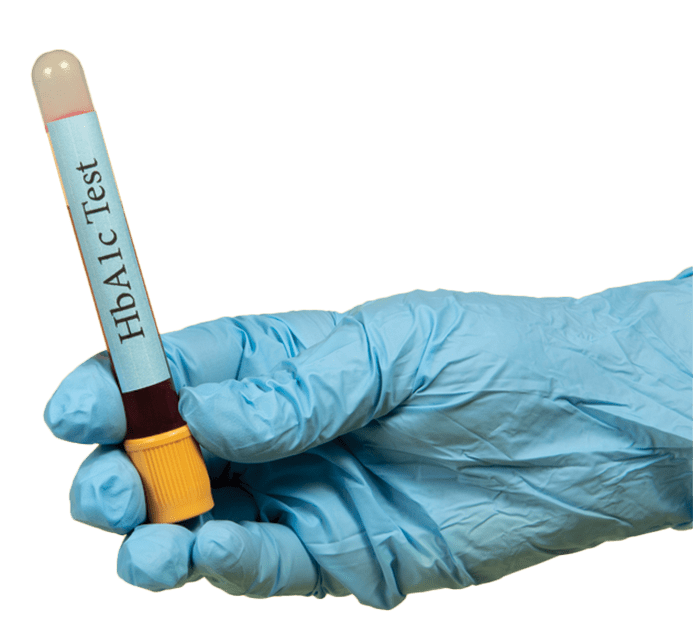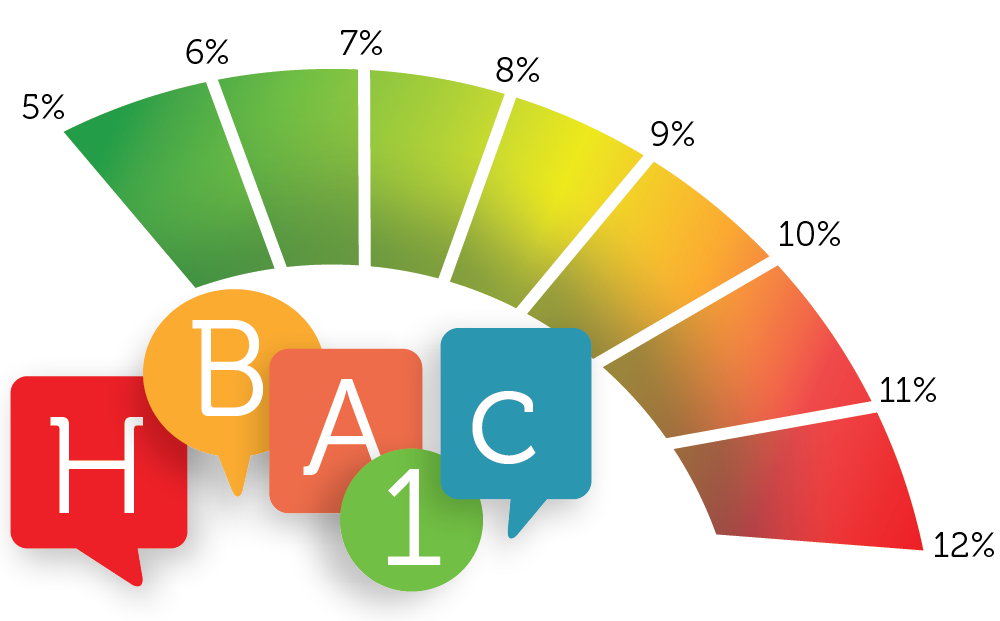
- Understanding various blood tests can help you to take charge of your diabetes.
- The HbA1c screens for type 1 and type 2 diabetes, and measures how well diabetes is being managed.
- Paying attention to your HbA1c results can help you to avoid complications like heart disease, stroke, nerve damage and kidney disease.
As someone with diabetes, you can take control of your health by working closely with your health care team. Part of this take-charge approach is understanding the various blood tests that help manage your diabetes. You also need to know when they need to be done and how to interpret them. One blood test, the HbA1c (hemoglobin A1c or glycated hemoglobin), shows overall blood glucose control. It represents your average blood glucose over the past two to three months.
The HbA1c measures the amount of sugar attached to the hemoglobin protein that is found in the red blood cell. The more sugar that sticks to the hemoglobin, the higher the A1c.
This test is generally done in medical labs although some medical offices, pharmacies and diabetes education clinics have portable machines.

Why is the A1c test done?
This test screens for and diagnoses type 1 and type 2 diabetes. It also monitors how well diabetes is being managed. The higher your A1c level is, the higher your risk of developing diabetes-related complications like heart disease, stroke, nerve damage and kidney disease.
Along with checking your blood glucose level at home, the HbA1c provides a better picture of how you are managing your diabetes. By using a glucose meter or continuous glucose monitor, you will know the actual level of glucose at the time when you check. If glucose levels are elevated, the HbA1c will be elevated. Together, these readings show if changes are needed to your treatment plan.
What does an A1c test result mean and why is it important?
The target A1c for most adults with type 1 or type 2 diabetes is at or below seven percent.
For some adults with type 2 diabetes, an A1c at or below 6.5 percent is better as the lower level further reduces the risk of kidney and eye disease. For others, an A1c at 7.1 to 8.5 percent is preferred. This includes those who have recurrent severe hypoglycemia or difficulty recognizing when they have hypoglycemia (low blood glucose). Your health care team can advise you on the right target for you.

A1c Targets
| From 2018 Diabetes Canada Clinical Practice Guidelines | |
|---|---|
| ≤7.0 | Most adults with type 1 or type 2 diabetes |
| ≤7.1 | 7.1 – 8.0%: functionally dependent* |
| 7.1 – 8.5%: | |
| 8.5 | Select patients at increased risk of hypoglycemia complications * |
| Avoid higher A1c to minimize risk of symptomatic hyperglycemia and acute and chronic complications. |
|
* Based on class of antihyperglycemic medication(s) utilized and person’s characteristics
How does the A1c compare to your blood glucose levels?
In Canada, blood glucose levels are measured in mmol/L while the A1c is measured as a percentage. This chart shows the comparisons between blood glucose levels and the A1c.
Good blood glucose control and reducing the A1c (even by one percent) are directly related to lowering the risk of complications associated with diabetes.
Why test glucose at home and in an A1c?
| SA1c | Average Blood Glucose Level |
|---|---|
| 14% | 19.7 mmol/L |
| 12% | 16.5 mmol/L |
| 10% | 13.4 mmol/L |
| 9% | 11.8 mmol/L |
| 8% | 10.1 mmol/L |
| 7% | 8.6 mmol/L |
| 6% | 7.0 mmol/L |
Your A1c only shows your average blood glucose over a two to three month period. It does not record daily fluctuations and is not necessarily an accurate record of blood glucose control. Consider someone whose blood glucose remains fairly constant between 6 and 8. This is good blood glucose control and will likely have an A1c in target. Another person might have poorly-managed blood glucose that fluctuates between 3 and 15. The A1c might look good in both people because it is measured over two to three months. However, their blood glucose control is very different. This is why regular blood glucose testing is so important. It can confirm whether your A1c accurately reflects your daily control.
Testing throughout the day with a blood glucose monitor or continuous glucose monitor is key to caring for your diabetes. Discuss how and when you test with your diabetes care team. Checking before meals and two hours after meals is recommended.
- The number you see when you check blood glucose before meals is known as the fasting blood glucose (FBG) or pre-prandial plasma glucose or pre-meal glucose.
- The number from checking blood glucose two hours after a meal is known as postprandial plasma glucose or post-meal glucose.
If pre-meal glucose levels are within the range of 4 to 7 mmol/L but the A1c is greater than 8 percent, we know that your blood glucose levels are likely elevated two hours after meals. The aim is to locate the high glucose and reach a target at two hours post-meals of 5 to 10 mmol/L. While both pre- and post-meal test results affect the A1c, lowering the post-meal test results will result in greater improvements if you are already at target before a meal.
Changes to your meals, activity or medications can help improve your A1c. Your diabetes nurse educator, dietitian, pharmacist or doctor can provide advice.
How often should you have your A1c tested?
Watching how your A1c changes over time is very useful. Diabetes Canada recommends repeating the test at least every three months when blood glucose targets are not being met, or when you are making changes to your diabetes management. This is because your A1c only shows average blood glucose over the past two to three months, with less than half of that value coming from the last 30 days. Once blood glucose levels remain within your target range when testing throughout the day and your A1c also reflects these goals, testing can be done every six months.
To achieve A1C ≤7.0
From Diabetes Canada
| A1c | Preprandial PG (mmol/L) | 2 hour Postprandial PG (mmol/L) | |
|---|---|---|---|
| For most patients | ≤7.0 | 4.0 – 7.0 | 5.0 – 10.0 |
| If A1c ≤7.0% not achieved despite the above plasma glucose (PG) targets | 4.0 – 5.5* | 5.0 – 8.0 |
It is always best to discuss the frequency of tests with your diabetes educator, pharmacist or doctor. As someone with diabetes, you should:
- know what tests should be done
- know what the tests indicate
- and know what to do if the results fall outside of your ranges.
Work with your pharmacist, diabetes educator and doctor to determine your glucose goals. Ask for more information on diabetes tests and preventing complications associated with diabetes. By using the information available, you can stay healthy with diabetes.
WRITTEN BY: Carol Stathers, RN.,
EDITED BY: Lisa Rocca, BSc (Pharm) CDE and Megan Tromposch, RPh, APA, CDE.

